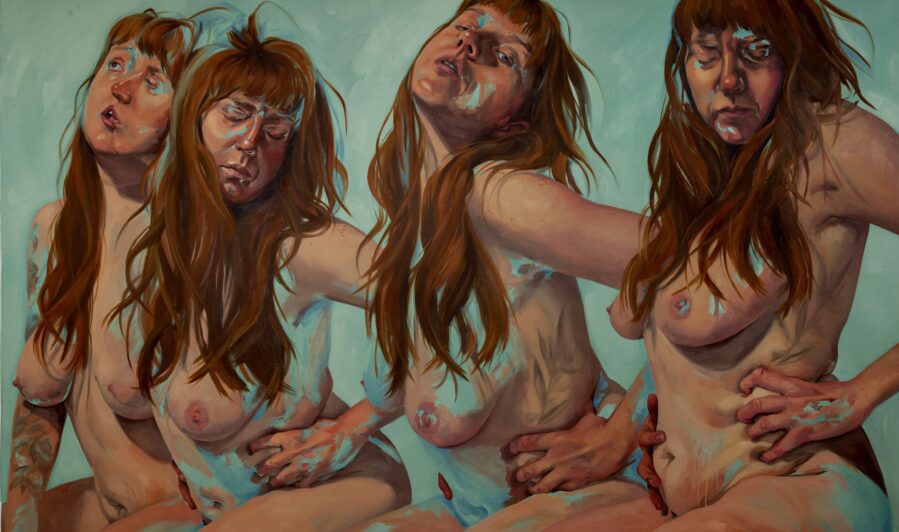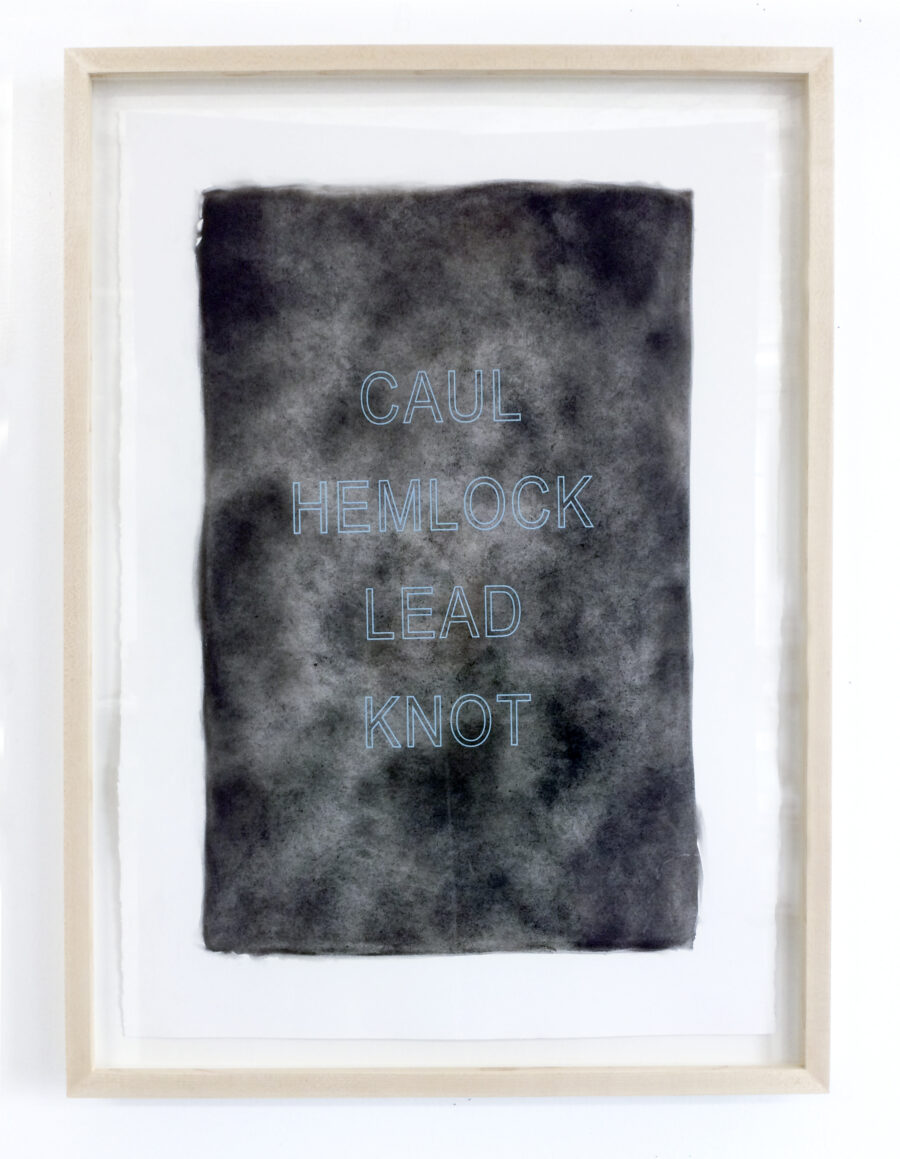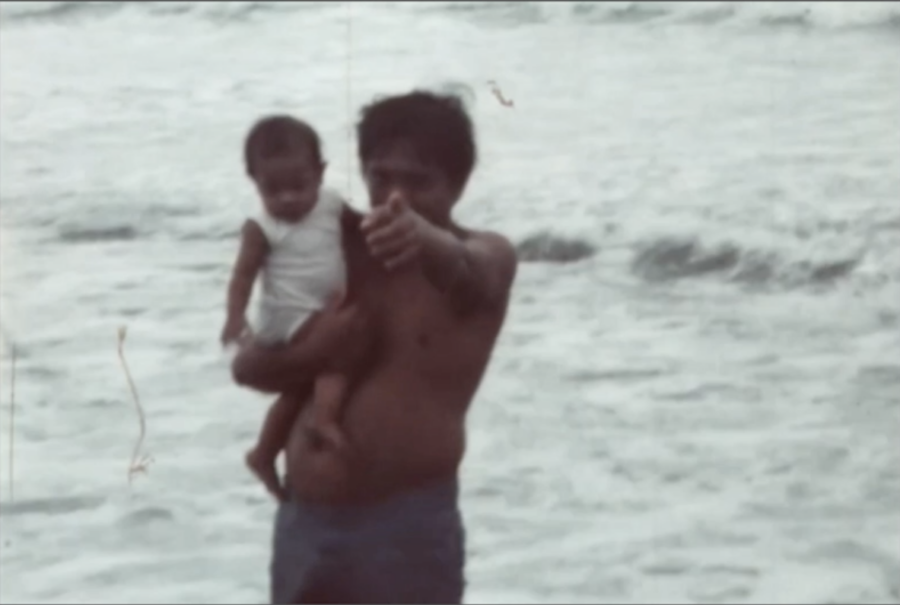
Laura Lewis, Self-Portrait in Oscillation, 2023, oil on canvas, 120 x 72 inches. Courtesy of
the artist.
- Friday, September 6–Friday, October 25, 2024
- MAWA, 329 Cumberland Ave, Suite 203, Winnipeg, MB
Held over to October 25!
Curated by Abigail Auld and Jenny Western
Opening party: Friday, Sept 6, 6 - 8 pm at MAWA
Exhibition continues Wed-Fri, Sept 11 - Oct 18, 10 am - 4 pm
Nuit Blanche: Saturday, Sept 28, 8-10 pm
With the support of The Winnipeg Foundation, VIEW Winnipeg, Gallery 1c03 and Video Pool Media Arts Centre.
Visual descriptions of the artworks provided. For other accessibility information please visit this page.
Curatorial Essay
To mark the 40th Anniversary of the Foundation Mentorship Program (FMP), MAWA asked us—Abigail Auld (mentee, 2019) and Jenny Western (mentor, 2010, 2019)—to curate an exhibition featuring work by past participants in MAWA’s core program since 1985. Over four decades, 400+ emerging and established artists have engaged in mentorship through this initiative. The breadth of FMP graduates is astonishing and artwork produced by this rich, multigenerational group could yield several distinct exhibitions. Yet, tasked with conceiving a small exhibition, we wrestled with how to approach the dynamic cohort and the impossibility of condensing varied experiences. Instead, rather than encapsulating the program as a whole, presenting works by the 11 artists in Reverberations connects with a founding motivation of the program—to foster resilience through interpersonal exchange.
From the outset, MAWA convened around mentorship, identifying intergenerational and peer-based learning as means to effect systemic change. Forty years later, reverberations across these relational networks have fundamentally altered the surrounding art ecology. In response, we found ourselves thinking about the significance of accessing and creating support systems. How are collective resiliencies and self-actualization nurtured? What kinds of exchange, correspondence and relationality allow divergent lifeforms to flourish and persevere?
For her series Table Making, Lisa Wood invited fellow artists to share a meal and conversation about art/life. Video documentation of these one-on-one encounters informed portraits that capture each subject mid-thought, in poses reminiscent of depictions of divine inspiration in art history. As viewers we are brought into this intimate exchange, witnessing the flicker of thought across the subjects’ expressions and gestures, and the open vulnerability intrinsic to processing ideas together.

AO Roberts, Caul Hemlock (Say it Ain't So #7), 2016, ink on lampblack on paper, 19.5 x 27.5 inches. Courtesy of the artist.
Like the exchanges evoked in Wood’s paintings, Jo-Anne Balcaen’s Survey for Cultural Workers / Questionnaire pour travailleurs culturels illuminates an essential force behind arts production. Balcaen posed questions about the daily challenges and motivations of cultural workers, and compiled the anonymized responses of curators, coordinators, administrators and technicians into a training-manual-like publication. These testimonies recount the psychic tensions of working between artists and organizational constraints—a tightrope walk that involves added weight for the cultural worker whose employment can both stabilize and confine their own artistic pursuits.
Though Laura Lewis’s Self-Portrait in Oscillation depicts a lone subject, the painting emerged in relation to others. Lewis explains that her turn toward self-portraiture occurred after years spent painting queer artists and friends. The strength and vulnerability shown by those who posed for her inspired Lewis’s turn inward, in part to reciprocate the gift of allowing oneself to be seen.[i] The resulting self-portrait explores multiplicities, examining the body, vulnerability and queerness, in relation to a community not present in the gallery but felt in the strength of self-knowledge shown here.
Francesca Carella Arfinengo explores a distant relational network through her revival of "dump" roses—discarded florist’s blooms— in dyed textiles. This work led Arfinengo to trace South American-grown flowers through Miami, Florida to shops across North America. Gifts Up the Chain developed as an offering of return, with dried roses bundled in dyed silk sent back through the supply chain. Arfinengo’s gallery installation is possible because some parcels were rendered undeliverable by disconnected postal networks, highlighting the profound asymmetry that enables networks of extraction.
Vi Houssin’s Principle of Correspondence examines delicate balance. Small, beadwoven tokens portray insects arranged in a seemingly symmetrical specimen-like display. Up close, the pinned mosquitoes, centipedes, water scorpions and dragonfly reveal schisms. Skewed colour inversions and shifted bilateral symmetry muddle the expected conventions of mirrored binaries, instead showing beauty in glitches, balance in asymmetry. Houssin links these expressions to the Métis beadwork practice of intentionally stitching in misshapen or off-colour “spirit beads” as an act of humility.
At first glance Mélanie Rocan’s Passing Through appears to be a circus tent that has collapsed. But upon closer inspection the colourful jumble of brush strokes appears to materialize and dematerialize an assortment of items before our eyes: a quilt, broken frames, the head of a hobby horse. The piece nudges us to consider the temporality of the natural world, a place we are only passing through. Here is the memory of something long past, an unstable exchange between the known and the remembered.
AO Roberts’s Say It Ain’t So meditates on loss and preservation through abstractions of technology, language and grief. Each text portrait corresponds to a person in Roberts’s life who has passed. Blackened surfaces reference a phonautograph—a 19th-century device that turned sound into a visual record, scratching soundwaves into lampblack-coated paper. Pastel text silkscreened over a soot surface imprints words from a glossary created by a 12th-century nun.[ii] Reaching across time, these portraits layer an extinct language and silent recordings in communion with those no longer here.

Leslie Supnet, Sing To Me That Song (still), 2020, video, 5min 25sec. Courtesy of the artist.
Leslie Supnet’s video Sing to Me the Song was created in 2020 as a reflection on how the grief and stress of isolation brought a newfound vividness to her dreams. Home movies, in conjunction with found footage of families visiting the Philippines, stand in as a metaphor for Supnet’s soaring dreamscapes. The subjects of her video appear so full of joy that there is a comfort here that transcends the subconscious state in a time of deep uncertainty.
Sarah Crawley’s body of work at the water's edge reflects on the grief she experienced at her mother’s passing. Crawley lay along the shoreline of a lake to capture the 45-minute exposure of the images seen through her hand-built pinhole camera’s aperture. This required her to stretch out across land and often freezing water, contemplating not only the loss of her mother but the liminal space upon which her vulnerable body rested. The resulting piece reflects a state of fragility.
Lita Fontaine has been a cultural leader and mentor in various capacities in the Indigenous art scene in Winnipeg and beyond, including her role as a MAWA mentor in 2009. Her work often uses bold colours alongside symbols such as the dress, the tipi, and the medicine wheel to explore powerful feminine energy, one that speaks to the important role of the individual and the community.
Aganetha Dyck has the honour of being one of MAWA’s very first mentors and the distinction of having participated in that role on five separate occasions over the years. As a cultural worker juggling many hats, one of her earlier works speaks to domestic labour by creating a sculptural piece consisting of canned buttons. The juxtaposition of the two materials, buttons and glass jars, is arresting, and the piece is made even more delightful by the fact that Dyck’s canned buttons are now, much like MAWA’s FMP, entering their fourth decade of existence.
While the artworks in Reverberations coalesce around themes of interrelation, the artists themselves bear connections that stretch across and beyond the group. Aganetha Dyck mentored Reva Stone who mentored Jo-Anne Balcaen, along a mentorship chain that extends to include 13 other artists. We co-curators were paired in mentorship, as was Lisa Wood + Laura Lewis, AO Roberts + Francesca Carella Arfinengo. The many who both received and provided mentorship include Sarah Crawley, Lisa Wood, AO Roberts, and Leslie Supnet. Vi Houssin’s beadwork insects originated as a response to an exhibition by another former mentee, Monique Fillion,[iii] while Lisa Wood’s portraits
feature AO Roberts and former mentee Jessie Jannuska. These intersections demonstrate the myriad ways in which mentorship sets off reverberations. And, from one participant to another, with artists standing alongside, next to, in front of, and behind one another, the ripple effects continue.
[i] Lewis, Laura, "Artist Talk with Laura Lewis" (lecture, Modern Fuel Artist-Run Centre, Kingston, Ontario, July 10, 2024). Online.
[ii] 12th-century abbess and composer Saint Hildegard of Bingen created the Lingua Ignota (unknown language).
[iii] Fillion, Monique, Embedded (exhibition, Martha Street Studio, Winnipeg, Manitoba, June 9 - July 14, 2023). https://www.printmakers.mb.ca/...
